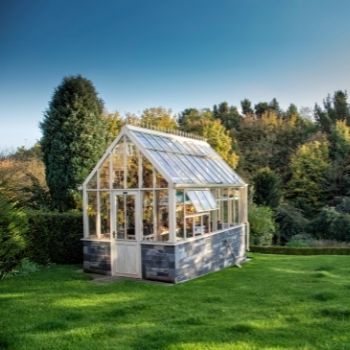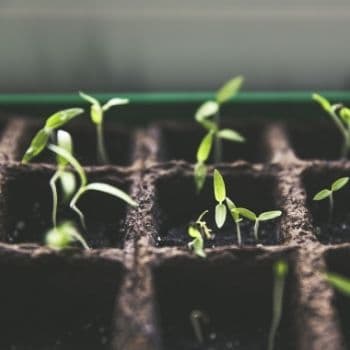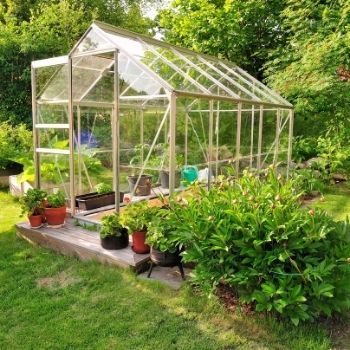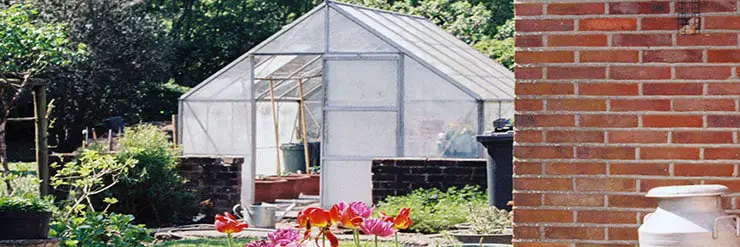Some people think that you can’t have a greenhouse if you don’t have full sun all day. But is that really true? Can a greenhouse be in the shade and still grow plants and vegetables?
A greenhouse can be in the shade and still grow plants and vegetables. The key is to provide enough light for photosynthesis, either through natural light or artificial light. Some plants actually prefer partial shade rather than full sun. It’s important to know the needs of what you are growing.
If you want to learn more about growing in a greenhouse that doesn’t receive much sunlight then keep reading to learn about how to increase the light needed and what to grow in a greenhouse in the shade
- Can a greenhouse be in the shade
- Can a greenhouse be in partial shade
- Will a greenhouse work in the shade
- Can I use artificial light for a greenhouse that doesn't receive much sun?
- Plants that Grow in Shady Greenhouses
- How Much Sun Does a Greenhouse Need
- Why Does a Greenhouse Need Sunlight
- How to Choose a Location for Your Greenhouse
- All in All
Can a greenhouse be in the shade
In general, greenhouses need to be in direct sunlight in order to function properly. The sun’s energy is what helps to warm the air and soil inside the greenhouse, which in turn helps to promote plant growth.
However, there are some circumstances under which a greenhouse can be built in a partial shaded environment.

Some plants and vegetables don’t need as much sunlight and thrive in a partial shade environment. In these cases, a shaded greenhouse can still be an effective way to cultivate plants.
Another possibility is to use reflective materials (Amazon link) to line the inside of the greenhouse. This can help to maximize the amount of light that is available, even if the greenhouse itself is in a shady spot.
Can a greenhouse be in partial shade
It is possible to have a greenhouse in partial shade, but it is important to consider the type of plants you want to grow and how much sun they need.
If you are growing plants that need full sun, then a greenhouse in partial shade may not be ideal.
However, if you are growing plants that can tolerate some shade, then a greenhouse in the partial shade can be a great option.
Just be sure to consider the needs of your plants when choosing a location for your greenhouse.
Will a greenhouse work in the shade
When you place a greenhouse in the shade or use an opaque roof, you block out most of that light, and whatever energy is created when the light strikes the objects inside the greenhouse dissipates before the temperature really rises.
That being said, some plants cant handle the intense summer sun, particularly around noon time when the sun is at its strongest, and therefore might benefit from some extra shading.
Placing a greenhouse in complete shade somewhat defeats the purpose of the greenhouse. At that point, your plants are getting the exact same advantage you give to a plant on your windowsill.
If you’re really bent on the idea of owning a greenhouse, though, there are some caveats to that statement.
We mentioned shade-loving plants- plants that grow in the shade will grow just fine in a greenhouse and have added protection of a closed-in space.
If you have a greenhouse in a partially shaded area then you will want to grow crops that thrive in that environment.
Can I use artificial light for a greenhouse that doesn’t receive much sun?
Yes, you can use artificial light for a greenhouse that doesn’t receive much sun. However, you will need to make sure that the artificial light is very bright and provides the right spectrum of light for the plants.
Plants need sunlight to photosynthesize, so they will need a lot of light if they are not getting any direct sunlight.
There are a few different types of artificial light that can be used to help plants grow in a greenhouse.
One type is a fluorescent light, which provides a broad spectrum of light that is similar to sunlight.
Another type is LED light (Amazon link), which can provide a more targeted spectrum of light depending on the plants that you are growing. LED lights are best suited for greenhouse growth because they consume less electricity than other types of lights.
Finally, high-pressure sodium lights are often used for greenhouses because they provide very bright light. However, all of these types of lights will need to be very bright in order to be effective.
Plants that Grow in Shady Greenhouses
Sun, soil, and water- are the three things that make a plant grow. Or, so we’re told. But what about all those plants we see growing on the forest floor? What about ramps and beets, which grow underneath trees abundantly?

The truth is that this rule, simple as it is, is just not true. In the end, every plant is unique and has adapted to different situations. If you’ve got a shady greenhouse, and want some plants that will work well for your purposes, try these few suggestions.
Beets
As mentioned above, beets grow very well in the shade. Beets are delightful little vegetables that grow deep in the ground where it’s dark and damp. But their tubers aren’t the only thing that likes a little shelter from the sun. Their leaves are built to take in energy from the sun without direct exposure to sunlight. Thus, they can grow in the shade of a tree, a wall, or a house just like if they were out on an open lawn.
Broccoli
Broccoli, an essential ingredient in many dishes and a great source of protein, is especially geared towards growth in the shade. It’s another one of those vegetables that chose to make the best of a bad situation- maybe it couldn’t grow as tall as the towering trees, but it could still thrive in the shade.
Bok Choi
Bok choi is a fantastic addition to any dish with a spicy zing. Bok choi grows in urban gardens with very little sun and provides people all over the world with a delicious source of nutrients that’s easy to start and grow.
Celery
Here’s one you definitely know. Celery can be cooked into soups and stir-fries and even just eaten raw. Celery with peanut butter is a classic treat that is best enjoyed with celery fresh from the garden, and what few people know is that garden-fresh celery has a special bite to it that just can’t be matched in grocery store varieties.
Related article:
How Much Sun Does a Greenhouse Need
It’s recommended that a greenhouse needs at least 6 hours of full sunlight. Certain plants wont fair well with this and will require parcial shade at times.
How much sun your greenhouse needs will depend on what kinds of plants you’re trying to grow, but there are some general guidelines.
In the winter, you’ll want to keep your greenhouse as warm as possible. To do this, you’ll want to put it somewhere where it can get six or more hours of direct sunlight every day. This applies to those spring and summer days, too, when the plants inside will be wanting as much sunlight as humanly- or vegetably- possible.
With greenhouses, the general rule of thumb is- the more sunlight, the better. More sunlight means more heat, which means your plants will stay at an acceptable temperature on chilly nights, and evaporated water will circulate amongst their leaves.

There are, however, partial shade plants that will work well for your purposes if you can’t provide this. A quick Google will pull up a detailed list of plants that grow in partial shade, so you can get cracking on that all-local diet you’ve been dreaming of or even just grow a few beets.
And keep in mind, greenhouses aren’t just for edible plants. There are many flowers and stunning plant species that enjoy a shady environment and will put your greenhouse to good use. So don’t let it sit out there all dormant-like- get a plant that works with what you can give it.
Why Does a Greenhouse Need Sunlight
Greenhouses, which act like big incubation chambers for plants, keep temperatures warm and constant for optimal growth. There are bound to be fluctuations in temperature in any given growing season, but a greenhouse can combat some of the effects this might have on your plants.
Also, some plants require a higher average temperature to truly flourish than what your latitude allows. Therefore, higher-temperature veggies will thrive in a greenhouse and will grow to their highest potential.
Greenhouses also help gardeners start their seeds earlier on in the season, allowing their plants to grow to maturity much faster and produce bigger yields.

But what does the sun have to do with all of this? Why is a greenhouse so suitable for growing plants, and how does exposure to direct sunlight make it what it is?
The answer lies in the materials used to build your average greenhouse. Greenhouses are made from transparent materials, like plastic or glass, which allow light in. After the light enters, it strikes objects in the greenhouse- cement, pots, soil, and plants, for example. This is where the magic begins.
While light may be allowed in, air- and heat- aren’t able to circulate and disperse as well as they would be outside. The energy from the sunlight striking the objects in a greenhouse thus gets trapped, gradually driving up the heat to a pleasant, sweaty, tropical temperature- great for plants whose ancestors always enjoyed tropical climates.
How to Choose a Location for Your Greenhouse
Alright, so you’ve got your materials ready- but where in the yard to put the greenhouse? There’s a tree over that way and a few garden walls rimming the place, but you’re sure they won’t cause a big problem.
Or will they?
With sunlight, all is not what it seems. Just because a spot isn’t shady now doesn’t mean it won’t be shady later. Make sure to survey your lawn at all hours of the day for places that stay sunny as long as the sun’s out.
Rule of thumb- find a spot in the middle of all your shade-casting objects. So, if you’ve got a big, shady house and trees around the edges of your lawn, put your greenhouse right in the center of the yard. This way, the shadows will steer clear of your sun-loving plants.
All in All
So, can a greenhouse be in the shade? You would do well to keep a greenhouse sunny, but it’s not an absolute requirement. If you’re growing sun-loving plants, which are a lot of them, they’re going to need the light, but with a little research, you can find shade-loving species.







